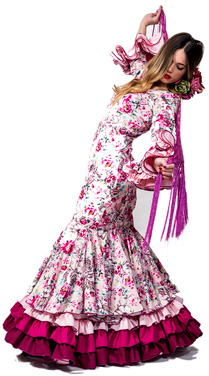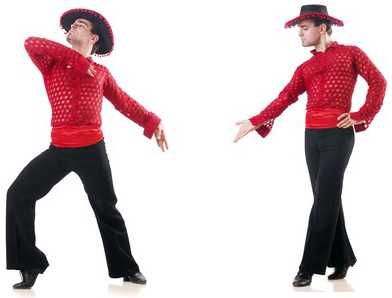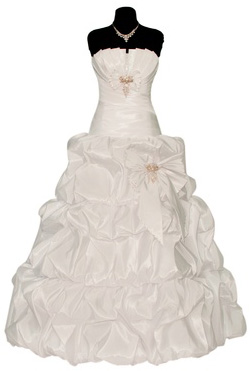Reading Comprehension Text and Exercises
Flamenco Dresses
What do you know about Spanish culture? Maybe when you think about Spain, one picture comes to mind. It is probably a Flamenco Dress! Flamenco dresses are outfits worn by women at festivals throughout the country.
Click Here for Step-by-Step Rules, Stories and Exercises to Practice All English Tenses
The Origin of the Flamenco Dress
Flamenco Dresses are typically very bright colored. They may be made of fabric with different patterns, like polka-dots. Usually, the colors in a flamenco dress are either black, red or white. They are usually form-fitting, meaning it hugs the body of the person wearing it. They often have ruffles along the skirt and the sleeve.
Flamenco dresses are often worn by dancers at festivals. Therefore, their style has to allow lots of body movement. For dancers, the skirts are designed so they are less tight around the dancer's legs.

In Spanish, the flamenco dress is called "traje de flamenca." Flamenco dresses came to Spain through Romani women. Romani people are commonly referred to as "gypsies." They were people who moved around a lot and were sometimes looked down upon by others because of their nomadic culture.
These Romani women came into Spain and went to different fairs where farmed goods and animals were sold. They came with their husbands, wearing dresses they had made themselves. They often took different fabrics from other clothes and things and hand sewed them together. They added ruffles and details to these dresses to make their plain fabrics more pretty. These dresses were ruffled and colorful, similar to the flamenco dress that we know now.
This style was adopted from the Romani women. The dresses became very popular among Spanish women and soon became the official outfit of the April fair in Seville, Spain.
The adoption of the flamenco dress was a way to overcome divisions in social class. While the Romani, low class women of Spain were looked down up, their outfits were adopted. It mixed women and lower families into the main culture of Spain. And it smoothed the divisions between them.
Soon after, the traditional "Flamenco" dance and music became an art form in the country. The dance usually involves lots of fast foot and arm movements. Elegant skirts and ruffled arms in the dresses emphasised the movements of the dance. It helped show emotion in the dancer. As flamenco music and dancing became an iconic part of Spanish culture, the dress became a part of it too. Now, it is the image that we have around the world for Spanish festivals.
Men also have a traditional flamenco outfits but it is not as iconic as the dress. It usually includes black pants and a white shirt under a black vest or coat. Both male and female flamenco dancers wear heeled shoes to showcase the sound. They often put nails in the soles to add sounds when dancing and tapping their feet.

Flamenco Dresses Now
The styles of the dress has changed with fashion. Gradually, dresses became shorter and shorter as modern fashion did too. Sleeves became longer. And as normal fashion became more simple and streamlined, so did flamenco dresses. Now, you can commonly find two piece dresses. These come with a top, and a separate skirt. This is reflective of changes in modern fashion. Flamenco dresses are now rarely worn everyday. Instead, they are commonly worn during big Spanish holidays, religious celebrations and pilgrimages.
The popularity of Flamenco dresses made an industry. You can easily buy a flamenco dress in Spain. Many people still like to create their own though. Making your own flamenco dress can save you money and also allow you to be creative!
There are also accessories to the dress that need to be included to complete the outfit. The flamenco dress is usually accompanied by heels, a shawl, a decorated hair comb, earrings and other jewelry.
The popular singer, Madonna, wore a flamenco dress in a music video in 1987. And many big fashion designers have used flamenco dresses to influence their own designs. There is also an International Flamenco Fashion Show in Seville, Spain each year. This show is a very big event in the country and an important part of the flamenco culture in Spain.
If you take a look at popular wedding dress designs in today's fashion, you can see that flamenco dresses have influenced their design. Tight skirts and extravagant ruffles show its influence in today's fashion, especially in wedding dress design. Also, extravagant sleeves in dresses showcase this influence too!

Travelling to Spain
Dressing in traditional clothes is a very big part of travelling. It can be quite a fun activity too! Are you planning on travelling to Spain? Do you want to wear a flamenco dress while you are there?
You can find many places to rent flamenco dresses for an evening out at a Spanish festival! But there are also many second hand stores selling flamenco dresses for cheap prices! You will find that there are many options available to you if you are travelling to Spain and want to dress in traditional garments.
Comprehension Exercises
Vocabulary Questions
- What does "gypsy" mean?
- Someone from Spain
- A nomadic or free spirited person.
- A person who sells cattle
- What does "adopt" mean?
- To take or own something that was not originally yours
- To believe in an idea
- Stealing something from someone else
- What does "elegant" mean?
- very simple in design
- ugly or unappealing
- pretty and stylish
- What does "ruffle" mean?
- fabric in the form of many folds
- straight fabric
- a scratched surface
- What does "traditional" mean?
- something that has been a part of a culture for a long time
- something that is very new in a culture
- a change in ideas or thoughts
Wh Questions
- Where are flamenco dresses found?
- Spain
- Italy
- Mexico
- Who originally brought flamenco dresses to Spain?
- African women
- Romani women
- Spanish women
- Why did flamenco dresses become part of flamenco dancing?
- Because their detail and ruffles helped emphasize the movements.
- Because it was a cheap way to make clothes for dancers.
- Because dancers found it easy to move in the dress.
- Where are flamenco dresses commonly worn?
- weddings
- funerals
- festivals
- How did flamenco dresses become part of Spanish culture?
- Spanish women adopted them from Romani women at fairs.
- Spanish women invented them to dance in.
- Men encouraged their wives to wear them.
Evaluating Statements
- Based on the information in this lesson, which statement is true?
- Flamenco dresses were very simple in design so they became popular.
- In Spain, Flamenco dresses were introduced through lower class women.
- Flamenco dressers are no longer worn by anyone.
- Based on the information in this lesson, which statement is false?
- Both men and women were flamenco outfits during flamenco dances.
- Flamenco dresses are usually very plain.
- There are many accessories that accompany flamenco dresses.
True or False?
- Based on the information in this lesson, is the following statement true or false?
"There are affordable options for tourists looking to wear flamenco outfits while visiting Spain." - true
- false
- Based on the information in this lesson, is the following statement true or false?
"Today if you travel to Spain, you will not see as many flamenco dresses being worn as there were in the past." - true
- false
Answer Key
1. B | 2. A | 3. C | 4. A | 5. A | 6. A | 7. B | 8. A | 9. C | 10. A | 11. B | 12. B | 13. A | 14. A
Get Updates, Special Offers, and English Resources
Download your FREE GIFT (the first two chapters of
English Short Stories Book and Workbook)
as soon as you join!

By submitting your email, you consent to receiving updates and newsletters from us and to the sharing of your personal data with third parties for the purposes of sending you communications. We will not spam you. You can unsubscribe at any time. For more information, please see our privacy policy.





